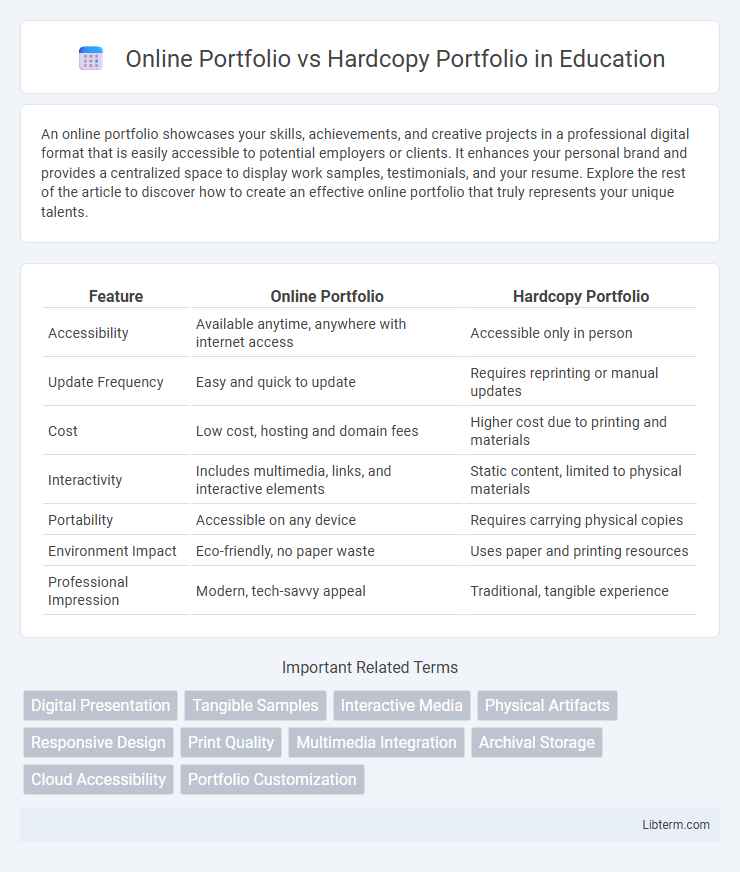An online portfolio showcases your skills, achievements, and creative projects in a professional digital format that is easily accessible to potential employers or clients. It enhances your personal brand and provides a centralized space to display work samples, testimonials, and your resume. Explore the rest of the article to discover how to create an effective online portfolio that truly represents your unique talents.
Table of Comparison
| Feature | Online Portfolio | Hardcopy Portfolio |
|---|---|---|
| Accessibility | Available anytime, anywhere with internet access | Accessible only in person |
| Update Frequency | Easy and quick to update | Requires reprinting or manual updates |
| Cost | Low cost, hosting and domain fees | Higher cost due to printing and materials |
| Interactivity | Includes multimedia, links, and interactive elements | Static content, limited to physical materials |
| Portability | Accessible on any device | Requires carrying physical copies |
| Environment Impact | Eco-friendly, no paper waste | Uses paper and printing resources |
| Professional Impression | Modern, tech-savvy appeal | Traditional, tangible experience |
Introduction to Online and Hardcopy Portfolios
Online portfolios offer dynamic, easily accessible platforms showcasing a wide range of digital media, including images, videos, and interactive elements, ideal for reaching a global audience. Hardcopy portfolios provide tactile, physical presentations of work, emphasizing material quality and tangible impact, often preferred in face-to-face interviews and design reviews. Both portfolio types serve to highlight skills and accomplishments, but online versions excel in convenience and multimedia integration while hardcopy portfolios excel in personal engagement and durability.
Key Differences Between Online and Hardcopy Portfolios
Online portfolios offer immediate global accessibility and dynamic multimedia integration, allowing users to showcase varied content such as videos, animations, and hyperlinks, unlike hardcopy portfolios that are limited to physical presentation and static formats. Hardcopy portfolios provide tactile engagement and reliability without requiring internet access or digital devices, often valued in traditional interviews or art exhibitions. Digital portfolios facilitate real-time updates and easier distribution, whereas hardcopy portfolios require physical reproduction for every change, impacting flexibility and cost efficiency.
Accessibility and Sharing Capabilities
Online portfolios offer superior accessibility and sharing capabilities compared to hardcopy portfolios, allowing users to showcase their work globally through various digital platforms and devices. They enable instant updates and easy distribution via links or social media, enhancing visibility and networking opportunities. Hardcopy portfolios, while tangible and personal, lack the convenience of remote access and rapid sharing inherent to online formats.
Customization and Flexibility
Online portfolios offer superior customization and flexibility, allowing users to easily update content, incorporate multimedia elements, and tailor layouts to suit different audiences or platforms. Hardcopy portfolios, while tangible and professional in settings like interviews, are limited by fixed formats and require time-consuming reprints for updates. Digital formats enable dynamic content integration and responsive design, maximizing adaptability across devices and contexts.
Cost and Resource Considerations
Online portfolios significantly reduce costs by eliminating expenses related to printing, shipping, and physical storage, making them a resource-efficient option for creatives and professionals. Hardcopy portfolios, while often viewed as tangible evidence of craftsmanship, incur ongoing costs for high-quality materials, printing, and frequent updates to maintain relevancy. Resource considerations also favor online portfolios, as they require minimal physical space and allow for easy, cost-effective revisions and multimedia integration.
Presentation and Visual Appeal
Online portfolios offer dynamic presentation features such as interactive galleries, videos, and animations that enhance visual appeal and engage viewers across various devices. Hardcopy portfolios provide tactile experience and physical presence, allowing the use of textured papers and finishes that create a memorable impression in face-to-face settings. Both formats benefit from high-quality images and cohesive design, but online portfolios excel in accessibility and multimedia integration.
Security and Privacy Concerns
Online portfolios offer convenient access but pose significant security and privacy concerns, including risks of unauthorized data breaches and cyberattacks that can expose sensitive personal information. Hardcopy portfolios provide physical control, reducing vulnerability to hacking but risk loss, theft, or damage without digital backups. Choosing between formats requires balancing accessibility with safeguarding confidentiality and controlling who views proprietary work.
Updating and Maintaining Your Portfolio
Updating an online portfolio is more efficient and flexible, allowing real-time edits and immediate access to the latest work, which enhances professional visibility. Hardcopy portfolios require physical reprinting and manual distribution, making frequent updates time-consuming and costly. The digital nature of online portfolios supports seamless integration of multimedia elements, enabling dynamic content updates that keep the portfolio fresh and engaging.
Industry Preferences and Trends
Industry preferences increasingly favor online portfolios due to their accessibility, ease of updating, and ability to showcase multimedia content such as videos, animations, and interactive designs. Creative sectors like graphic design, marketing, and web development prioritize digital portfolios for their seamless integration with social media and professional platforms like Behance and LinkedIn. Despite this trend, certain industries such as architecture and fine arts still value hardcopy portfolios for tactile presentation and physical material qualities that reflect craftsmanship and attention to detail.
Choosing the Right Portfolio Format for You
Choosing the right portfolio format depends on your industry, audience, and presentation goals. An online portfolio offers easy accessibility, multimedia integration, and rapid updates, making it ideal for digital and creative professionals seeking broad exposure. A hardcopy portfolio provides tangible proof of work quality and craftsmanship, preferred for in-person interviews or fields valuing physical presentation, such as architecture or fashion design.
Online Portfolio Infographic

 libterm.com
libterm.com